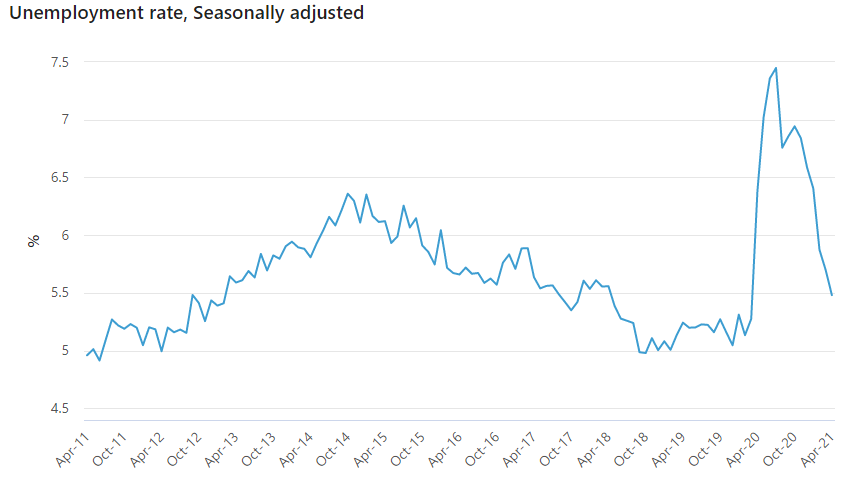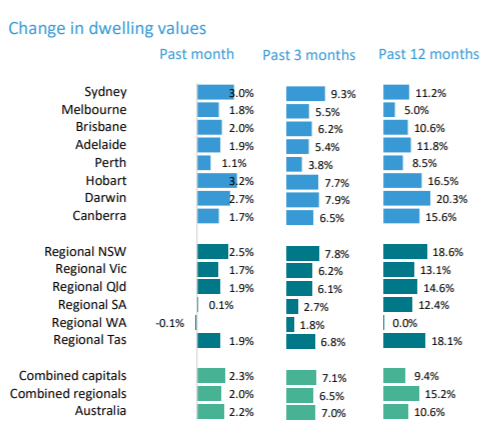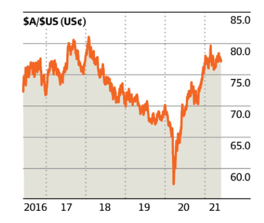June 2021: Rate Decision & Analysis.
The Reserve Bank of Australia ("RBA") left the official cash rate at 0.10% at its June meeting.
Tough news for Victorians, the experience from other lockdowns is that the economy recovers quickly after opening, though this is the first one without significant Government support. It may put a lag on an already lagging Victorian economy.
More broadly however, the tone has changed both globally and in Australia into a post recovery stance. Leading the positive sentiment, was the ABS data estimating that business spending on capital expenditure to its largest increase in nearly a decade.
A number of other KPI's remain ahead of expectations, including unemployment rates as demonstrated by the ABS prepared data below.

This data of a strong employment conditions was also supported by ANZ Research that showed an increase in average salary deposits, despite the end of Job Keeper.
In terms of sentiment, the ANZ-Roy Morgan Consumer Confidence was up 1.7pts to its highest level since September 2019, though took a decent step down in Melbourne with lockdown. However, the survey highlighted the number of households (over 40%) that expect to be ‘better off’ financially in a year, compared to only 16% that expect to be ‘worse off’.
Australia climbs Global Economic Ladder
Data released from the International Monetary Fund builds estimates of the GDP (in USD) of each country for the preceding year. Australia is now ranked as the world's 13th largest economy, just behind Brazil which obviously has a far greater population.
There is no country ranked above Australia with a smaller population. The US assumed the mantle of world's biggest economy from the UK around 1870 but it didn't really exercise that authority until 1945. China is No 2 with a GDP 70% or America's; in 2000 China's economy was 12% of America's. At this rate China will command the world's and history's largest economic force before 2030.
The pace of growth is also relatively strong in other developed economies but not at the same pace as the US.
Direction for Local Interest Rates?
The recent RBA commentary stating that rate increases would not emerge until 2024, may be tested soon. First signs will be if the RBA suspend its bond buying program, especially with banks accounts being already full of cash reserves.
There have also been a number of statements by other central banks, including New Zealand, Canada and the US, stating they were open to either raising interest rates or winding back their stimulus programs.
Again, for those calling the bottom for interest rates, the arguments have strong foundations.
Money Markets
Another quiet month on Money Markets. The steady line in all market rates, was perhaps a little surprising given the otherwise upbeat economic data.
The numbers below show another slight tail off in the 10 year bond.
| Month | Cash Rate | 90 Day Bill Rate | 10 Year Bond |
| September 2020 | 0.25% | 0.12% | 0.84% |
| October 2020 | 0.25% | 0.10% | 0.90% |
| November 2020 | 0.10% | 0.05% | 0.81% |
| December 2020 | 0.10% | 0.05% | 0.90% |
| February 2021 | 0.10% | 0.03% | 1.09% |
| March 2021 | 0.10% | 0.04% | 1.69% |
| April 2021 | 0.10% | 0.05% | 1.74% |
| May 2021 | 0.10% | 0.04% | 1.65% |
| June 2021 | 0.10% | 0.04% | 1.59% |
The spread between short and long term rates will remain a crucial test of the market's view of the economy, including inflation, and the longer term direction of interest rate settings more broadly.
Property
In the residential market, data from CoreLogic listed below, shows continued growth Australia’s housing boom rolls on with national home values lifting another 2.2% in May, which is actually increased growth from the previous month. Just when we thought it may be slowing a little.

Annual returns remain very strong, in fact some of the annual growth numbers are astonishing and the areas of growth are diverse.

NSW Property Demand Keeps Building
The NSW Productivity Commission recently completed its report on the its property market. It makes the case that Sydney faces large housing shortages in the second half of the 2020's, that without more development will require Sydney suburbs to accept much higher-density living.
This is supported by the the proportion of children living with their parents. This has increased by around 10% in the last decade to around 33%, mainly because of the cost of housing.
USA Property Prices Surge
The prices of residential property in the US surged the most since the end of 2005.
Their property market has been fuelled strongly by the demand for the properties in the suburbs, as opposed to apartments in higher density urban areas, with low interest rates and scarcity also driving the growth.
Growth, measured by the the S&P CoreLogic Case-Shiller index showed that property values climbed 13.2% in the month of March alone.
Commercial Property
The commercial property position remains very strong. A spotlight on retail property in Melbourne were several properties where several properties went well above reserve, and some crazy low yields.
Currency
Our currency has entered a relatively steady period. This was a slight surprise given a volatile recent history, but trading around long term averages as the Bloomberg graph below demonstrates.

Even with an expected softening of commodity prices, experts still predict a rise back to over 80 cents as the year progresses.
Until next time.

